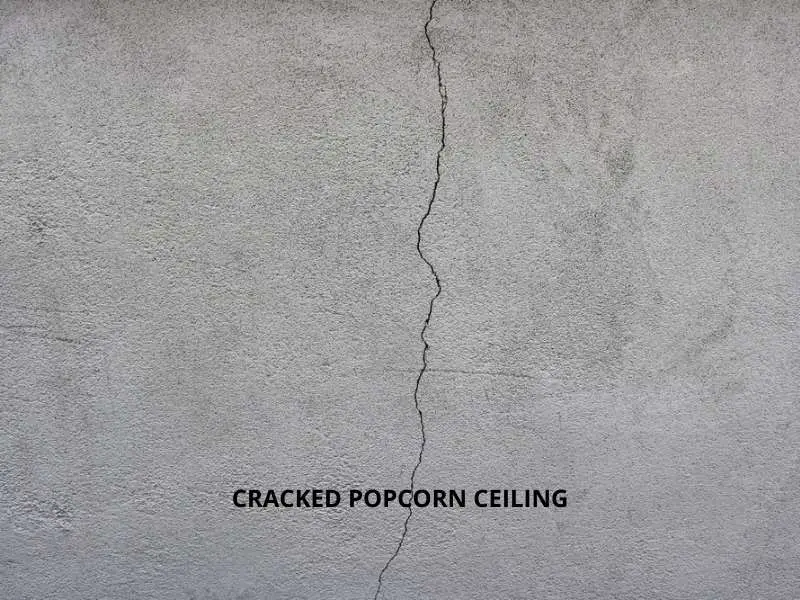Cracking Popcorn Ceiling: Causes, Repair, Crack Size + Safety
In most cases, cracks in popcorn ceilings are shallow and only an aesthetic problem that can easily be fixed as a small DIY project as I’ve shown below. However, if the crack is big, you want to examine any structural defects in your ceiling. Cracks that are wider than 3 millimeters may signal a serious structural problem. So, how do you repair a cracking popcorn ceiling?
A cracked popcorn ceiling can be caused by poorly taped joints, moisture problems, truss uplift, house settling, or major structural issues. Apply white caulk over the thin, hairline cracks and smooth it over with the tip of your finger to fix and cover the lines.
If the cracks are big, have the roof inspected by a construction specialist. Examining the size, shape, and location of the cracks can help you unearth possible causes and effective interventions.
What Causes Cracks in Popcorn Ceiling?

Popcorn ceiling is used in many homes to cover up a lot of imperfections in the ceiling. The ceiling is cost-effective, easy to install, and good for soundproofing. However, over time virtually all homes with popcorn ceilings develop cracks in the ceiling.
1. Poorly taped joints
A fine straight crack on the popcorn ceiling could be due to a poorly taped joint. Usually, when painting a popcorn ceiling, masking tape is applied to the joints to protect the walls. If you use a small amount of drywall mud during taping, the tape won’t embed perfectly on the joints. As a result, you’ll notice fine straight cracks along the edges of the popcorn ceiling.
2. Moisture problem
If you notice discolored cracks on the popcorn ceiling, it could be a moisture problem that’s causing it. Sometimes, water from the attic may leak through the popcorn ceiling, loosening the joint tape as a result. The loosened tape appears as yellow or brown cracks.
Note that if the house has moisture problems, you’ll also start experiencing mold, bulging and crumbling drywall, and many other structural problems in your home.
SEE ALSO: HOW TO REPAIR A WATER-DAMAGED POPCORN CEILING
3. Over-thinning or over-thickening the paint
A popcorn ceiling is designed from paint-on or spray-on treatments. Tiny particles of polystyrene, vermiculite, or other treatments are applied to the ceiling to create a bumpy or textured appearance. Insufficient surface prep is usually the reason for the cracking.
Over-thickening the paint or applying it too thinly can lead to cracks. Making your paint too thick causes tiny cracks that run in all over the popcorn ceiling because the paint shrinks as it dries – especially if you try to cure it faster.
4. Truss uplift
Signs of cracking on the corner of the popcorn ceiling are common as a result of truss uplift. Truss uplift occurs when the truss is exposed to extreme temperature and moisture conditions. Temperature and moisture fluctuations cause the center of the truss to bend upwards. The movement in turn causes a horizontal crack between the ceiling and interior wall.
5. House settling
Cracks on the popcorn cells that extend to the walls could be a result of the house settling. Over time, houses of any age move and shift slowly and this natural movement may cause weaker parts to crack. Settling can produce cracking noises in your ceiling at night or at random times of the day. Later, you’ll see some fine cracks in the paint of the textured ceiling.
5. Structural problem
Diagonal or jagged cracks on the popcorn ceiling could signal a structural problem that requires prompt attention. It indicates that the foundation or pillars may have sunk or shifted – due to the installation of something heavy on the floor such as a pool, waterbed, or hot tub. A popcorn ceiling may also crack if a load-bearing wall is not removed properly.
Is cracked popcorn ceiling dangerous?
Minor cracks in popcorn ceilings are not dangerous because they are shallow and remain within the thickness of the paint. However, cracks that are wider than 3mm should be checked and repaired as soon as possible as they can point towards a major structural problem in the ceiling and roof of your house.
If the ceiling cracks are due to poorly taped joint, over-thinning or over-thickening the paint, or normal settling of a home, there is nothing to worry about. However, if you notice large diagonal or jagged cracks that extend to the walls caused by structural damage, then you need to take prompt action.
How to Repair a Crack in Popcorn Ceiling
The steps involved during repair vary depending on the extent of the crack. In this section, I’ve highlighted the steps of repairing a small hairline crack and cracks larger than 1/8 inch.
Here’s how to repair small hairline cracks in popcorn ceilings:
1. Remove the ceiling fixtures
First, you need to remove ceiling fixtures near the crack. This includes things such as air vents, chandeliers, and lights.
2. Apply caulk
Put the tip of the caulking gun at the start of the crack and draw the gun down the crack. Use the tip of the caulking gun to smoothen the caulk as you continue to draw. You can also use your fingers to smooth the caulk and remove access caulk from the surface.
3. Allow the caulk to dry
Once the caulk is applied to the cracks and smoothened, allow it to dry completely. Properly drying will take 2 to 3 hours.
4. Spray popcorn treatment
Shake a bottle of popcorn ceiling texture and spray the patched area carefully, following the manufacturer’s instructions. Overlap the existing popcorn ceiling texture slightly to ensure uniformity. Allow the treatment to dry completely.
5. Apply a primer
Shake a bottle of spray primer for the recommended time. Using an airless paint sprayer, spray the patched area with a spray primer until the desired results are obtained. Allow the spray to dry completely.
Here’s how to fix cracks larger than 1/8 inch:
Step 1: Remove the fixtures
Remove ceiling fixtures near the crack, at least 2 inches around the crack. This includes things such as air vents, chandeliers, and lights.
Step 2: Install backer rod
Use your fingers to insert foam backer rods into the big gaps left by cracks. Set the rod approximately 5 to 7 mm in the crack, lower than the surface of the popcorn ceiling.
Step 3: Fill and smooth the joint
Fill the crack with ceiling caulk and use your fingers, the back of the old spoon or the tip of the caulking gun to smooth the joints.
Step 4: Repeat steps 3 to 5 of caulking small cracks on the ceiling.
Can You Use Aerosol Spray Texture Repair Kits To Fix Cracks?
Yes. You can use aerosol spray texture repair kits to repair small cracks on the ceiling but not big cracks.
Most of these kits come with a bottle of premixed spray texture, a sprayer, and a small mud knife. For instance, Homax® Wall & Ceiling Touch Up Sprayer is an easy-to-operate spray texture repair kit ideal for repairing small cracks and damaged textured ceilings and walls.
Crack Size and Safety
It is worth noting that the size of the cracks in your ceiling can point to whether or not they are serious. Here are the different sizes of cracks and how to handle them:
1. Hairline cracks
These cracks are usually very thin or fine, approximately smaller than 1.59 mm (1/16- inch). You don’t have to worry about hairline cracks because they are purely cosmetic in nature.
2. Spiderweb cracks
Spider web cracks are those cracks on the popcorn ceiling that have a central point and extend diagonally or circularly from that center. They have an appearance of a spider web – usually, appear as a result of cracking plaster or paint. You don’t have to worry about spider web cracks because they are a normal part of a natural home settling.
3. Matching vertical cracks
These types of cracks begin on the floor, go up the wall, and extend across the popcorn ceiling. They signal serious structural damage and therefore require immediate attention.
4. Straight cracks at taping joints
Straight cracks at taping joints are usually caused by improper application of drywall tape and mud. They are very straight and very thin because they follow the straight edge of the drywall tape. If you notice those kinds of cracks on your popcorn ceiling, just keep in mind that your safety is not at stake. You shouldn’t worry about them.
When it comes to popcorn ceiling cracks, the size, shape, and location of those cracks determine whether you should stay put or take an immediate intervention. While you may be able to look at the crack and know what exactly is happening, it’s advisable you seek a professional opinion about the same.
